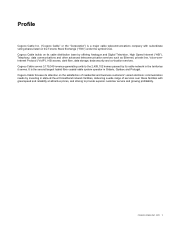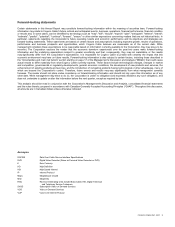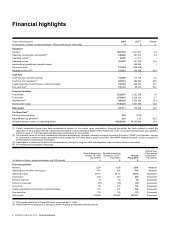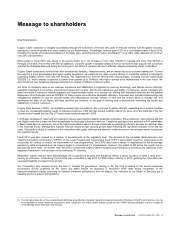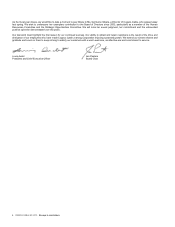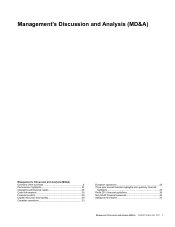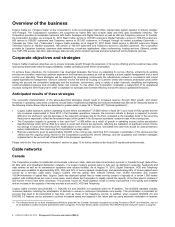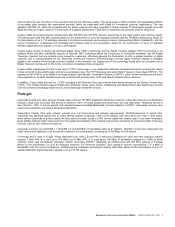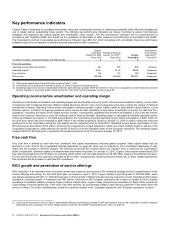Cogeco 2010 Annual Report Download - page 10
Download and view the complete annual report
Please find page 10 of the 2010 Cogeco annual report below. You can navigate through the pages in the report by either clicking on the pages listed below, or by using the keyword search tool below to find specific information within the annual report.Management’s Discussion and Analysis (MD&A) COGECO CABLE INC. 2010 9
that can allow the use of portions of the spectrum that are not otherwise usable. This gives Cogeco Cable a flexible and expandable platform
for providing other products like symmetrical services, which are particularly well suited for commercial customer applications. The new
standard, DOCSIS 3.0, while still compatible with the earlier versions, will make it possible to further increase IP transmission speeds up to 160
Mbps and beyond. Cogeco Cable is in the process of a gradual deployment of DOCSIS 3.0 head-end and customer premise equipment.
Cogeco Cable has implemented an infrastructure with 550 MHz and 750 MHz capacity, depending on the cable system and customer needs.
The infrastructure with 550 MHz capacity allows for the transmission of up to 80 analogue channels and the 750 MHz infrastructure allows for
the transmission of up to 110 analogue channels. For reference purposes, each analogue channel (representing 6 MHz of bandwidth), with the
current compression, multiplexing and modulation technologies used by the Corporation, allows for the transmission of up to 15 standard
definition digital television signals, or of up to 3 HD signals.
Cogeco Cable intends to deploy the Switched Digital Video (“SDV”) technology and the Digital Terminal Adapter (“DTA”) technology in its
systems where and when bandwidth capacity is required. SDV technology allows the Corporation to selectively broadcast only the Digital
Television channels that are currently being viewed by customers, effectively allowing the Corporation to offer a greater selection of digital
channels, and is used particularly for low viewership content and channels. DTA technology converts Digital Television signals to analogue
signals in the viewer’s home through a device installed on the television set. Deployment of this technology would allow for a broader use of
Digital Television service and for the further conversion of analogue channel capacity.
Cogeco Cable is deploying the Fibre to the Home (“FTTH”) technology in new residential subdivision developments which meet specific criteria
of size, proximity to the existing plant and service penetration rate. The FTTH topology selected is Radio Frequency Over Glass (“RFoG”). The
primary benefit of RFoG is the ability to leverage existing Cable Modem Termination Systems (“CMTS”), cable modem investments and back-
office applications, all while maintaining service continuity with existing video, VoIP, and ultra-broadband Internet services.
In addition, Cogeco Data Services Inc. (“CDS”) operates a 625 kilometre fibre optic network that extends throughout the Greater Toronto Area
(“GTA”). The multiple facilities based infrastructure (Ethernet, Dense wave division multiplexing and Multiprotocol Label Switching) connects
over 600 commercial buildings within the city and enables high bandwidth services.
Portugal
Cabovisão provides its cable services through state-of-the-art 750 MHz broadband distribution networks. Cabovisão fully owns its distribution
networks, head-ends and drops. HSI service is offered to 100% of homes passed and served by a two-way cable plant. Telephony service is
also offered to 100% of homes passed, with standard based embedded Multimedia Terminal Adapters (“e-MTA”). Cabovisão currently uses
class-5 circuit switches and class-5 advanced softswitches.
Cabovisão’s intercity fibre optic network extends over 3,414 kilometres and includes approximately 232,000 kilometres of optical fibre.
Cabovisão has deployed optical fibre to nodes serving clusters of typically 1,200 homes passed, with many fibres per node in most cases,
which allows Cabovisão to further extend the fibre plant to smaller clusters of 500 homes rapidly with relative ease if and when necessary.
Node splitting leads to further improvements in the quality and reliability of the network and services and allows for increasing traffic of two-way
services, such as HSI, VOD and Telephony.
Cabovisão currently uses DOCSIS 1.1, DOCSIS 2.0 and DOCSIS 3.0 standards within its IP platform. DOCSIS 3.0 has been deployed in all
major centres and expansion to all homes will continue in the coming years, providing up to 120 Mbps for HSI service.
In Portugal and in most of Europe, Phase Alternated Line (“PAL”) B and PAL G television standards are used and each analogue channel
requires 7 MHz (PAL B is used up to 300 MHz) and 8 MHz (PAL G is used above 300 MHz) of bandwidth compared to 6 MHz in North
America, which uses the National Television System Committee (“NTSC”) standards. An infrastructure with 750 MHz capacity in Portugal
allows for the transmission of up to 83 analogue channels. For reference purposes, each analogue channel (representing 7 or 8 MHz of
bandwidth), with the current compression, multiplexing and modulation technologies used by Cabovisão, allows for the transmission of up to 13
standard definition Digital Television signals, or of up to 6 HD signals.


